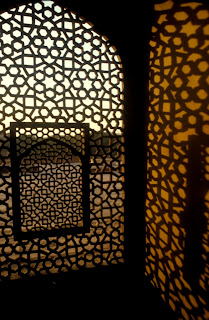Red Fort evening
A couple of weeks ago I posted an album of the acclaimed sarodiya Ustad Hafiz Ali Khan of Gwalior.
Tonight I’m proud to share with you another stunning set of this
gorgeous instrument, played by Hafiz
Ali’s son, Ustad Amjad Ali Khan.
Ustad Amjad Ali Khan
was born on 9 October 1945 at Gwalior and was initiated into music at the age
of 5 by his father, the reknowned Ustad
Hafiz Ali Khan. At age 11 he was participating in important concerts like
the Sadarang Sangeet Sammelan in Calcutta. At 15 the prestigious Prayag Sangeet
Samiti declared him ‘Sarod Samrat’. Amjad, the child prodigy has since won
scores of awards and honors.
At 25 he was presented the UNESCO Award by the International
Music Forum (Paris) and at 29 he was honoured with the Padma Shri by the
President of India becoming one of the youngest recipients of this Award. Ustad Amjad Ali Khan has performed
extensively in India and abroad. In this his 9th albumb with HMV, he
tells listeners about his investment with Music, explaining the ragas he has played.
***
My dear friends, More music festivals are held today, and larger audiences point to the fact that those who have cared to involved themselves in music have been amply rewarded. Young people often tell that they ‘understand’ film and pop music whereas they find classical music difficult to follow. Perhaps it is simple to follow words rather than notes, but ‘getting initiated’ always takes time. Listening itself constitutes a major part of learning classical music.
My dear friends, More music festivals are held today, and larger audiences point to the fact that those who have cared to involved themselves in music have been amply rewarded. Young people often tell that they ‘understand’ film and pop music whereas they find classical music difficult to follow. Perhaps it is simple to follow words rather than notes, but ‘getting initiated’ always takes time. Listening itself constitutes a major part of learning classical music.
Indian music comes alive in the moment of performance whee
the audiences inspires the artiste to elaborate the rag in unexpected ways. This mutual attentiveness should not be
underestimated. I too began my music career listening to my father, often
reluctantly.
Perhaps this explains why my album is called, Prisoner of Conscience. When I started
learning music at the age of 5, the notes of a rag used to trap my body and soul. I wanted to break free but my
father/guru was firm. Operating with
the constraints of the notes, time taught me how to stretch my boundaries, to
redefine my skies. I had consciously and willingly offered myself as a prisoner
to this challenge.
I invite you to enter this wonderful prison and discover
your freedom. For the benefit of new listeners I would like to mention that the sarod in its present form, was derived
from an Afghan folk instrument called the Rabab.
The credit goes to Ghulam Ali Khan
Bangash, a revered ancestor of my family. My own sarod, differes from the previous ones in as much as it has only 3
large pegs on either side instead of four.
It is fortunate that the musical tradition in my family has
remained unbroken for six generations. My sons Amaan and Ayaan, are the seventh, and it is my
greatest wish that they continue and enrich this legacy. The options and
temptations in this world are many but the music passed on as a precious
heirloom cannot be frittered away without guilt.
My father Ustad Hafiz
Ali Khan Saheb was my guru. He
belonged to an illustrious line of sarod
players at the court of Gwalior. He had learned from eminent masters like Ustad Nanne Kha Saheb (my grandfather),
Pandit Chukka and Pandit Ganeshilal (said to be
descendants of Swami Haridas) and Ustad Wazir Khan Saheb of Rampur, a
direct descendant of the great MIyan
Tansen, singer at Akbar’s court.
By a long line of descent my own training is thus traced back to the pristine Senia Gharana.
On side 1 of this album I have
played Raga Shahana sometimes called Shahana Kanhra. There are four
compositions, the first in a slow tempo set to ihap taal (a cycle of 10 beats), the second in medium teen taal (16 beats), the third in a
somewhat faster ektaal (twelve
beats), and finally the drut to a
fast teen taal. The beautiful rag
dates back to the 17th century and is said to have been
composed by Hazrat Amir Khusrau, the
great Sufi saint who attempted to combine the Persian and Indian music
systems. Usually Shahana is a favourite of the vocalists but its lyrical flow also
takes well to instrumental music though more subtly. Most of its bandishes (compositions) are based on khayal ang (a vocal style).
On side 2 you will hear rag Tilak Kamod, a more familiar rag which vocalists often sing in thumri form. The origins of this popular
but difficult rag are shrouded in
history. Its emotions vary and recur, creating a lilting effect reminiscent of
folk music.
This rag blossomed at the court of Nawab
Hamid Ali Khan of Rampur, the royal pupil of Ustad Wazir Khan. The slow vilambhit
gat and the fast drut are both
set to the 16 beats of the teen taal.
In this album too I introduce to you a
talented young tabla player Shafaat Ahmed Khan, son and student of Ustad Chamma Khan of the Delhi gharana.
I hope you will enjoy our music. (Amjad
Ali Khan, 1980)
(from the Liner Notes)
Track
Listing:
01. Raga Shahana
02. Raga Tilak Kamod
Listen here




1 comment:
Link gone dead. Missed the album.
Post a Comment